Content available at: Indonesia (Indonesian) Melayu (Malay) ไทย (Thai) Tiếng Việt (Vietnamese) Philipino
- Artificial intelligence (AI) is reshaping the future of various industries, and the poultry sector is no exception.
- Machine learning (ML) and predictive analytics are both segments of Artificial intelligence (AI). AI predictive analytics use machine learning (ML) techniques and models that acquire knowledge from data over time.
- These models undergo training using past data in order to recognize and analyze patterns and interactions (Ravi et al., 2018).
- After being trained, the models are utilized to create predictions about future outcomes using new, previously unseen data (Figure 1).
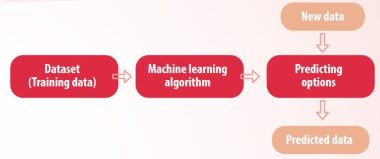
Disease and inadequate hygiene are two of the many problems that confront the chicken production sector. Coccidiosis, Newcastle, Gumboro pullorum, and Salmonella are among the most prevalent diseases (Machuve et al., 2022).
- The diagnostic testing for these diseases can be expensive, time-consuming, and laborious.
Bacteriological testing on chicken excrement, for instance, can cost an average of $30 from American laboratories (e.g., GPLN and others), with pricing fluctuating based on the quantity of birds tested (GPLN, 2024; CEVDL, 2024).
- Keeping a close eye on certain birds for any changes in behavior or appearance can help poultry workers quickly pinpoint and eliminate the disease’s cause.
This is where predictive analytics have provided a breakthrough solution for the poultry industry.
- Farm managers can take appropriate measures even before the diseases manifest clinically, thanks to predictive analytics models that derive results from historical data and real-time inputs to forecast outbreaks.
- Modern analytics, in the form of machine learning algorithms and powered by big data technologies, combines these two imperatives by enabling an analysis that can both detect patterns today and predict future diseases.
DATA COLLECTION AND MANAGEMENT
- The key to successful predictive analytics in poultry farming is the collection and management of different data.
- The prominent data types on the farm include environmental factors like temperature, humidity, and air quality (key for poultry health).
- Tracking them helps to forecast conditions that may favor a disease outbreak (Jung et al., 2021; Johansen et al., 2019).
- Moreover, sensors and video surveillance can help monitor bird behavior (feeding patterns, activity levels, and interactions with surroundings) (Figure 2).
- Such behavioral indices can help identify distress or disease at earlier stages than traditional assessment alone (Reboiro-Jato et al., 2011).
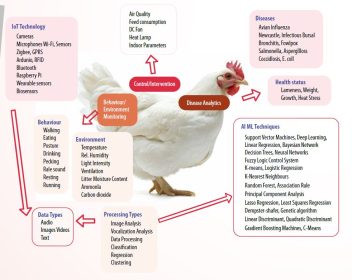
Health records, which include vaccination history, medication records, and previous medical diagnoses, are another important dataset.
- This insight is essential for better risk disease modeling and understanding the temporal health issue patterns that might spread throughout an entire flock (Huang et al., 2019).
The scale and complexity of these data types require reliable systems to process, validate, and use all this information for real-time conclusions.
Internet of Things (IoT) devices and sensors primarily automate data collection, providing continuous input to integrated management systems.
State-of-the-art databases and cloud storage solutions store the massive amount of data.
Data analytics platforms utilize advanced algorithms and machine learning models to analyze the data, look for hidden relationships or patterns in the processed ways, and predict possible outcomes (LeCun et al., 2015) (Figure 3).
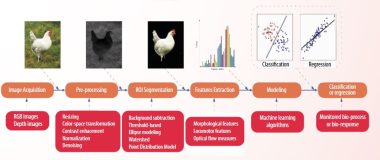
PREDICTIVE MODELS FOR DISEASE DETECTION
ML-based techniques employ feature extractors to transform raw data, such as pixel values from photos, into feature vectors.
- In addition, learning subsystems are employed to perform regression or identify patterns in the acquired features (LeCun et al., 2015).
Deep learning algorithms, derived from conventional machine learning techniques, have the ability to autonomously discover features or data representations from raw data, eliminating the need for knowledge in feature extraction engineering (LeCun et al., 2015).
- Recurrent neural networks, autoencoders, convolutional neural networks, belief networks, generative adversarial networks, and reinforcement learning are all models that make up deep learning architectures.
- To solve difficult problems, deep learning networks need high-performance processing systems, large datasets, optimization methods to keep data immutable, and complex topologies (Oyedele et al., 2021).
- Convolutional neural networks are widely used in deep learning for the purpose of digital image processing (Zhuang & Zhang, 2019).
Most machine learning systems use past data as input to project future output values. Learning algorithms (e.g., ANN, SVR, random forest, CNN, GLM) and many learning models (e.g., classification, regression, clustering) define ML as either supervised or unsupervised (Milosevic et al., 2019). Supervised learning methods ensure the correctness of their classifications or predictions by means of labelled data.
CASE STUDIES
- Robertson and Yee created an automated data extraction and analysis pipeline using four keywords linked with poultry infection with AIV to examine Twitter tweets on AIV. Their model showed a positive relationship between avian influenza cases in poultry reported by the World Organization for Animal Health and Twitter posts linked to AIV between 2015 and 2016 (Robertson & Yee, 2016).
- Belkhiria et al. (2018) created a disease distribution map to project California’s high pathogenicity avian influenza virus (HPAIV) risk. They combined several kinds of data, including the count of broiler farms in a given location, the distance to coastlines, and the historical low pathogenic avian influenza virus infection count of wild birds, to create their result. The map links areas of California with HPAIV infection risk, therefore enabling the use of suitable precautions should an outbreak strike.
BENEFITS OF EARLY DETECTION
- One of the primary advantages is the significant reduction in bird mortality rates.
- Early detection greatly reduces the reliance on antibiotics, traditionally used as a blanket preventive measure.
- By preventing outbreaks, farms can avoid the substantial costs associated with mass culling and lost productivity.
IMPLEMENTATION CHALLENGES AND SOLUTIONS
Infrastructure problems, economic challenges and data governance concerns will be among the challenges facing the development of a standardized system to forecast the emergence of diseases in poultry.
- There is insufficient internet access in rural farm areas, leading to a lack of connectivity. Additionally, the development of sensors and biosensors for diagnosing poultry infections is still in its early stages.
- Therefore, further research is required to create technology that can effectively operate in a commercial poultry house environment.
The adoption of new technology on farms necessitates that farmers acquire knowledge and training in those areas. The problem of bias and noise in particular data sources is another obstacle that predictive algorithms will have to overcome.
- As an example, assessments relying on web-based sources often end up with a lot of noise and useless data that needs to be deleted (Milinovich et al., 2014).
Farmers might have experienced data governance problems when considering harmonized prediction models with several stakeholders. While models should include information from as many farms as feasible to predict disease development, producers might not wish their data made public.
- Data can be anonymised, but re-identification methods are improving (Ferris, 2017).
Improving data quality, building technical expertise, and reducing economic and operational barriers can effectively implement predictive analytics, leading to enhanced disease management and improved operational efficiency (Figure 4).
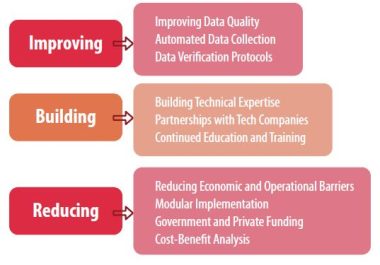
- Furthermore Ojo et al. (2022) proposed a strategy aimed at enhancing precision livestock farming for intelligent poultry health and welfare.
- Their approach specifically tackles the obstacles encountered in current systems. This notion was formulated by a comprehensive examination of previous treatments conducted by other researchers in the field of poultry welfare management.
- The framework possesses the qualities of scalability, resilience, extensibility, and security.
The framework consists of several fundamental components, namely the deep learning (DL) module, Digital Twin module, cloud edge computing (cloud-fog-based) module, communication module, security module, and user-interface module (Figure 5).
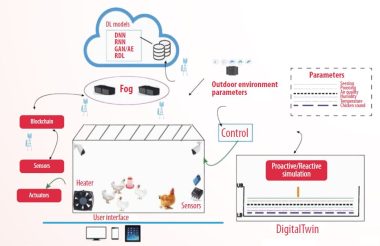
FUTURE PROSPECTS AND INNOVATIONS
- The future of predictive analytics in poultry farming is expected to improve with artificial intelligence (AI) and machine learning, as well as an integration into Internet of Things (IOT) devices and big data that would greatly enhance what these technologies can do.
- To ensure commercial viability and applicability, poultry monitoring systems require further research and development.
Integrated approaches in livestock science and engineering must address these challenges to improve the overall performance of chicken monitoring in a PLF and increase its resilience (Figure 6).
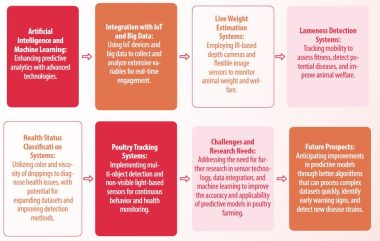
LIVE WEIGHT ESTIMATION SYSTEMS
Monitoring animal weight over development helps one assess slaughter time and feeding plans. Should the measured weight deviate from the expected growth curve, it suggests a condition such as disease or other vitality issues requiring counteractions. Live weight thus defines the welfare of animals.
- The main difficulties for chicken weight estimate systems are variable ambient lighting and flock localization.
Flexible image sensors and illuminant invariant cameras for farms would address the changing light problem. Weight estimation makes advantage of IR-based depth cameras such as Microsoft Kinect (Mortensen et al. 2016).
LAMENESS DETECTION SYSTEMS
Mobility is crucial for living organisms. Being mobile is associated with fitness and wellness.
Birds with trouble walking can starve, decreasing their feed conversion ratio, weight and growth, chest soiling, hock burns, and be vulnerable to predators.
According to wellbeing-Quality® (2009), the foregoing variables indicate poor animal wellbeing. Thus, tracking a bird’s mobility indicates its welfare.
HEALTH STATUS CLASSIFICATION SYSTEMS
- Wang et al. (2019b) used dropping color and viscosity to diagnose digestive disorders in broilers.
- Feed type can also affect falling color.
- Water intake also affects decreasing viscosity.
- Thus, this method would be difficult to use with free-range or diverse-fed hens. Additional research should be done to create a poultry dataset with particular categories such broiler, layers, chicks, etc., fit for usage in poultry detecting systems.
- Still, the retraining process of new applications would make this labor intensive. Therefore, a lot of study should be directed on innovative learning strategies, like semi-supervised learning and adaptive learning.
POULTRY TRACKING SYSTEMS
The evaluation of behavioral (types of activities) and physical (lameness and health) factors in poultry welfare depends critically on tracking of poultry.
- Behavior phenotyping and welfare monitoring demand for constant recording of bird movement and behavior phenotyping.
Zhuang and Zhang (2019) have already implemented multi-object detection in unhealthy broiler detection, which has recently garnered significant attention.
- Furthermore, additional research should be conducted on DL networks that employ non-visible light-based sensors to combat illumination variation issues and enable tracking to be conducted during nighttime hours (lighting regime).
INTEGRATING IOT AND BIG DATA
When we consider the integration of IoT devices with big data, it revolutionizes predictive analytics in poultry farming by providing farmers with more detailed information.
- By incorporating sensors, cameras, and the IoT in general, big data platforms are utilized to analyze a wide range of variables, from environmental factors to individual bird behavior, and then feed this data into a platform for real-time engagement (Nakrosis et al., 2023).
- Adding AI functionality not only broadens the scope of data analysis but also expedites the process, enhancing the efficiency and promptness of decision-making.
We hope that the increase in accuracy and efficiency of predictive models will continue to trend this way as solutions
combining bio-analytics, AI, and machine learning improve over time.
- Better algorithms, which have the potential to process datasets more complex than ever before faster and far from perfect, are just beginning to emerge.
- This will enable us to identify the rarer, smaller signals of impending outbreaks before full pathology emerges, and potentially identify new disease strains as they emerge.
CONCLUSION
- Predictive modeling helps mine historical and real-time data to provide heads-up alerts on likely health outcomes, preventing diseases before they happen.
- By moving from reactive to proactive management practices, we can optimize animal welfare and bring about considerable economic gains in the form of decreased mortality rates, reduced medication spending, or expedited turnover tracking.
- The use of AI and machine learning technologies has further enhanced the accuracy and timeliness of these predictive systems’ decision-making.
- In addition, the introduction of IoT devices and big data analytics has further evolved this landscape, providing advanced insights and monitoring support.










